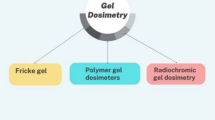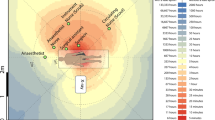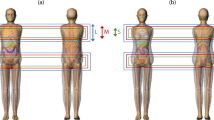Abstract
Studies on beam optics and the isocenter property in the gantry system for the SC200 (Superconducting Isochronous Cyclotron of 200 MeV in Hefei, China) are presented in this paper. The physical design of the isocentric gantry system is developed with the software TRANSPORT, which realizes a beam with a circular shape at the isocenter and a full width at half maximum of 4–10 mm. For stereotactic radiosurgery, the isocenter deviation of the gantry system should be less than 1 mm in diameter. In order to explore the property of the isocenter, an electromagnetic structure coupling analysis has been conducted given the self-gravity and the electromagnetic (EM) force of the magnets on the gantry beam line. The correlation between the isocenter property and the EM force has also been carefully studied. This paper puts forward two methods to obtain the isocenter deviation based on the characteristics of the nozzle installation structure and the calculation of the optical path after the nozzle, respectively. The results show that the maximum isocenter deviation is less than 0.33 mm with a safety factor of 1.5, and the deviation caused by the EM force is 0.05 mm. The latter result indicates that the impact of the EM force is negligible. This paper puts forward one possible way to realize real-time acquisition of the isocenter deviation in practical application. The gantry of SC200 is under construction at ASIPP.












Similar content being viewed by others
References
H.L. Riis, S.J. Zimmermann, M. Hjelmhansen, Gantry and isocenter displacements of a linear accelerator caused by an add-on micromultileaf collimator. Med. Phys. (2013). https://doi.org/10.1118/1.4789921
A.M. Koehler, Preliminary design study for a corkscrew gantry, in Proceedings of the Fifth PTCOG Meeting: International Workshop in Biomedical Accelerators (Lawrence Berkeley Laboratory, Berkeley, CA, 1987), p. 147
E. Pedroni, T. Böhringer, A. Coray et al., A novel gantry for proton therapy at the Paul Scherrer Institute. AIP Conf. Proc. 600, 13–17 (2001). https://doi.org/10.1063/1.1435184
E. Pedroni, R. Bearpark, T. Böhringer et al., The PSI gantry 2: a second generation proton scanning gantry. Z. Med. Phys. 14, 25–34 (2004). https://doi.org/10.1078/0939-3889-00194
Y. Iwata, T. Fujimoto, S. Matsuba et al., Beam commissioning of a superconducting rotating-gantry for carbon-ion radiotherapy. Nucl. Instrum. Methods Phys. Res. A 834, 71–80 (2016). https://doi.org/10.1016/j.nima.2016.07.050
A. Koschik, C. Baumgarten, C. Bula et al., PSI gantry 3: integration of a new gantry into an existing proton therapy facility, in 7th International Particle Accelerator Conference (IPAC 16), JACOW, Geneva, Switzerland (2016), pp. 1927–1929
G. Karamysheva, Y. Bi, G. Chen et al., Compact superconducting cyclotron SC200 for proton therapy, in Proceedings of Cyclotrons and their Applications 2016, Zurich, Switzerland, pp. 371–373
X. Ding, M. Bues, M. Zhu et al., SU-FF-T-291: measurement of the mechanical isocenter of a proton gantry. Med. Phys. 34, 2468 (2007). https://doi.org/10.1118/1.2760953
S. Price, S. Goddu, L. Rankine et al., SU-E-J-213: imaging and treatment isocenter verification of a gantry mounted proton therapy system. Med. Phys. 41, 206 (2014). https://doi.org/10.1118/1.4888266
H. Schiefer, N. Ingulfsen, J. Kluckert et al., Measurements of isocenter path characteristics of the gantry rotation axis with a smartphone application. Med. Phys. 42, 1184 (2015). https://doi.org/10.1118/1.4906248
M.F. Moyers, W. Lesyna, Isocenter characteristics of an external ring proton gantry. Int. J. Radiat. Oncol. Biol. Phys. 60, 1622–1630 (2004). https://doi.org/10.1016/j.ijrobp.2004.08.052
P. Spiller, D. Boehne, A. Dolinskii et al., Gantry studies for the proposed heavy ion cancer therapy facility in Heidelberg, in Proceedings of 7th European Particle Accelerator Conference (EPAC), Cern, Geneva (2000), pp. 2551–2553
D.C. Carey, K.L. Brown, F. Rothacker et al., TRANSPORT, a computer program for designing charged particle beam transport systems, SLAC Report No. SLAC-R-95-462
X. Zhang, W. Fan, S. Shi et al., Average vector method for determining isocenter of rotated radiotherapy equipment. J. Tsinghua Univ. 8, 470–472 (2015)
T. Obana, T. Ogitsu, Magnetic field and structure analysis of a superconducting dipole magnet for a rotating gantry. Physica C 471, 21–22 (2011). https://doi.org/10.1016/j.physc.2011.05.213
Author information
Authors and Affiliations
Corresponding author
Additional information
This work was supported in part by the National Natural Science Foundation of China (No. 51507173).
Rights and permissions
About this article
Cite this article
Li, M., Zheng, JX., Song, YT. et al. Beam optics and isocenter property of SC200 proton therapy gantry. NUCL SCI TECH 29, 112 (2018). https://doi.org/10.1007/s41365-018-0446-5
Received:
Revised:
Accepted:
Published:
DOI: https://doi.org/10.1007/s41365-018-0446-5




